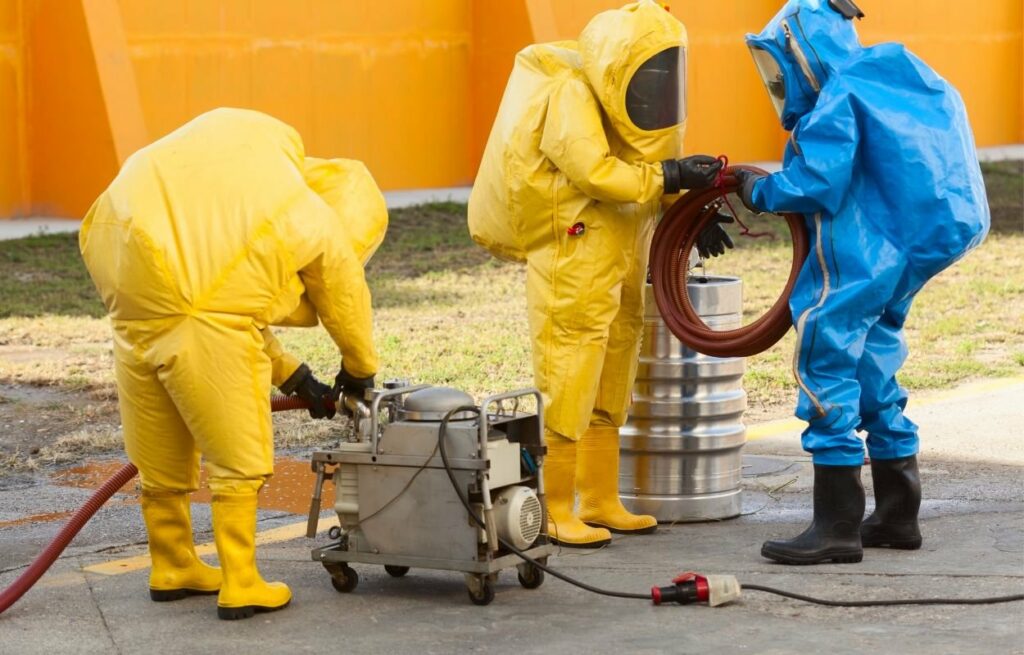
Hazmat materials, short for hazardous materials, are substances or materials that pose a risk to health, safety, property, or the environment. In businesses, the presence of hazmat materials is not uncommon, whether it’s in the form of cleaning agents, industrial chemicals, or other substances. Understanding common hazmat materials found in businesses is crucial for ensuring proper handling, storage, and disposal to prevent accidents and environmental harm. This blog post aims to shed light on some of these common hazmat materials and emphasize the importance of hazmat abatement for businesses.
INDUSTRIAL CHEMICALS
Industrial chemicals are commonly found in various businesses, ranging from manufacturing plants to laboratories. These chemicals include solvents, acids, bases, and other substances used in production processes. Improper handling or storage of industrial chemicals can lead to spills, leaks, or chemical reactions, posing significant risks to employees and the surrounding environment.
CLEANING AGENTS
Businesses often use a variety of cleaning agents to maintain cleanliness and hygiene in their premises. These agents may contain hazardous ingredients such as bleach, ammonia, or strong acids. While effective for cleaning purposes, these substances can be harmful if not handled properly. Hazmat abatement for businesses involves implementing safe storage practices and providing adequate training to employees on the use of cleaning agents.
BIOLOGICAL HAZARDS
In certain industries like healthcare, laboratories, or food service, biological hazards are prevalent. These hazards include bloodborne pathogens, infectious agents, and biological toxins. Proper handling and disposal of biological materials are essential to prevent the spread of diseases and protect the health of workers and the public.
FLAMMABLE MATERIALS
Flammable materials such as gasoline, propane, or alcohol-based solvents are commonly used in businesses for various purposes, including fueling equipment or cleaning. However, these materials pose fire hazards if not stored or handled correctly. Hazmat abatement for businesses involves implementing fire safety measures and storing flammable materials in designated areas away from ignition sources.
TOXIC SUBSTANCES
Toxic substances, including pesticides, heavy metals, and certain industrial chemicals, can cause harm to human health and the environment. Exposure to these substances can lead to acute or chronic health effects, ranging from respiratory problems to neurological disorders. Businesses must identify and properly manage toxic substances to minimize risks to employees and the community.
ELECTRONIC WASTE
With the rapid advancement of technology, businesses generate a significant amount of electronic waste (e-waste) from discarded electronics such as computers, monitors, and printers. E-waste often contains hazardous materials like lead, mercury, and cadmium, which can leach into the environment if not disposed of properly. Hazmat abatement for businesses involves implementing e-waste recycling programs and ensuring compliance with regulations for safe disposal.
Hazmat materials pose significant risks to businesses, employees, and the environment if not properly managed. By identifying common hazmat materials and implementing effective hazmat abatement strategies, businesses can minimize the likelihood of accidents, protect human health, and reduce environmental pollution. It is essential for businesses to prioritize safety, training, and compliance with regulations to ensure the responsible handling, storage, and disposal of hazmat materials. Remember, hazmat abatement for businesses is not just a legal requirement but also a moral obligation to safeguard lives and the planet.





